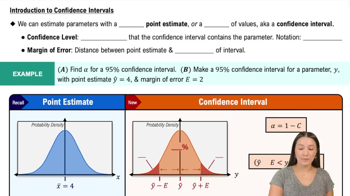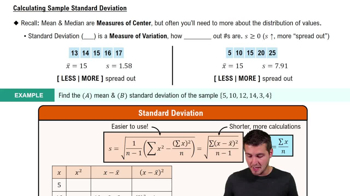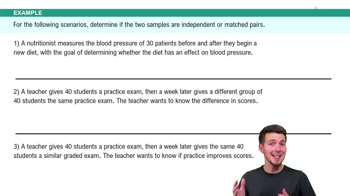Body Temperature Data Set 5 “Body Temperatures” in Appendix B includes a sample of 106 body temperatures having a mean of and a standard deviation of 0.62F (for day 2 at 12 AM). Construct a 95% confidence interval estimate of the standard deviation of the body temperatures for the entire population.
Table of contents
- 1. Intro to Stats and Collecting Data1h 14m
- 2. Describing Data with Tables and Graphs1h 55m
- 3. Describing Data Numerically2h 5m
- 4. Probability2h 16m
- 5. Binomial Distribution & Discrete Random Variables3h 6m
- 6. Normal Distribution and Continuous Random Variables2h 11m
- 7. Sampling Distributions & Confidence Intervals: Mean3h 23m
- Sampling Distribution of the Sample Mean and Central Limit Theorem19m
- Distribution of Sample Mean - Excel23m
- Introduction to Confidence Intervals15m
- Confidence Intervals for Population Mean1h 18m
- Determining the Minimum Sample Size Required12m
- Finding Probabilities and T Critical Values - Excel28m
- Confidence Intervals for Population Means - Excel25m
- 8. Sampling Distributions & Confidence Intervals: Proportion1h 12m
- 9. Hypothesis Testing for One Sample3h 29m
- 10. Hypothesis Testing for Two Samples4h 50m
- Two Proportions1h 13m
- Two Proportions Hypothesis Test - Excel28m
- Two Means - Unknown, Unequal Variance1h 3m
- Two Means - Unknown Variances Hypothesis Test - Excel12m
- Two Means - Unknown, Equal Variance15m
- Two Means - Unknown, Equal Variances Hypothesis Test - Excel9m
- Two Means - Known Variance12m
- Two Means - Sigma Known Hypothesis Test - Excel21m
- Two Means - Matched Pairs (Dependent Samples)42m
- Matched Pairs Hypothesis Test - Excel12m
- 11. Correlation1h 6m
- 12. Regression1h 50m
- 13. Chi-Square Tests & Goodness of Fit1h 57m
- 14. ANOVA1h 57m
7. Sampling Distributions & Confidence Intervals: Mean
Confidence Intervals for Population Mean
Problem 7.2.10
Textbook Question
Atkins Weight Loss Program In a test of weight loss programs, 40 adults used the Atkins weight loss program. After 12 months, their mean weight loss was found to be 2.1 lb, with a standard deviation of 4.8 lb. Construct a 90% confidence interval estimate of the mean weight loss for all such subjects. Does the Atkins program appear to be effective? Does it appear to be practical?
 Verified step by step guidance
Verified step by step guidance1
Step 1: Identify the key components of the problem. The sample size (n) is 40, the sample mean (x̄) is 2.1 lb, the sample standard deviation (s) is 4.8 lb, and the confidence level is 90%. Since the sample size is greater than 30, we can use the t-distribution to construct the confidence interval.
Step 2: Determine the critical t-value for a 90% confidence level. To do this, calculate the degrees of freedom (df = n - 1 = 40 - 1 = 39) and use a t-distribution table or statistical software to find the t-value corresponding to a 90% confidence level (two-tailed).
Step 3: Calculate the standard error of the mean (SE). The formula for the standard error is: , where s is the sample standard deviation and n is the sample size.
Step 4: Construct the confidence interval using the formula: . Plug in the values for the sample mean (x̄), the critical t-value, and the standard error (SE) to calculate the lower and upper bounds of the confidence interval.
Step 5: Interpret the results. If the confidence interval includes 0, it suggests that the mean weight loss might not be significantly different from 0, meaning the program may not be effective. Additionally, consider whether the mean weight loss (2.1 lb) is practically significant in the context of weight loss goals.
 Verified video answer for a similar problem:
Verified video answer for a similar problem:This video solution was recommended by our tutors as helpful for the problem above
Video duration:
6mPlay a video:
Was this helpful?
Key Concepts
Here are the essential concepts you must grasp in order to answer the question correctly.
Confidence Interval
A confidence interval is a range of values, derived from sample statistics, that is likely to contain the true population parameter. In this case, it estimates the mean weight loss for all adults using the Atkins program. The width of the interval reflects the uncertainty around the estimate, and a 90% confidence level indicates that if the same procedure were repeated multiple times, 90% of the intervals would contain the true mean.
Recommended video:

Introduction to Confidence Intervals
Standard Deviation
Standard deviation is a measure of the amount of variation or dispersion in a set of values. In the context of the Atkins program, a standard deviation of 4.8 lb indicates that individual weight losses varied significantly around the mean of 2.1 lb. A high standard deviation suggests that while some participants may have lost a lot of weight, others may have lost very little or none at all, impacting the overall effectiveness of the program.
Recommended video:
Guided course

Calculating Standard Deviation
Effectiveness and Practicality
Effectiveness refers to how well a program achieves its intended outcome—in this case, weight loss. Practicality considers whether the program can be realistically followed by individuals in their daily lives. Evaluating the Atkins program involves analyzing the mean weight loss and its confidence interval to determine if the results are statistically significant and if the weight loss is substantial enough to be considered practical for long-term adherence.
Recommended video:
Guided course

Introduction to Matched Pairs Example 1

 4:48m
4:48mWatch next
Master Population Standard Deviation Known with a bite sized video explanation from Patrick
Start learningRelated Videos
Related Practice
Textbook Question
